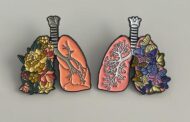
Joan H. Schiller, MD, FACP
Joan H. Schiller, MD, FACP, of the Lung Cancer Research Foundation, and Oncology Screening Consultant Christine Berg, MD, in partnership with the IASLC’s Early Detection and Screening Committee’s Environmental Working Group, have led the creation of an official position on air pollution from the association.
As the authors of the statement note, nearly 15% of lung cancer cases worldwide are thought to be caused by air pollution.1 However, air pollution often does not get the level of attention compared to other lung cancer causes such as smoking, radon, and asbestos. Released on Earth Day, the position statement, which can be read below, is part of IASLC’s support for clean air advocacy.
In addition, the authors of the statement will be working on manuscript in coming months that will discuss the following:
- The evidence on air pollution and lung cancer
- The type and source of outdoor and household lung carcinogens
- The geographic variation of attributable risk
- The impact of air pollution exposure on lung cancer risk in people living in areas of higher risk
- The effect of air pollution in patients with lung cancer
- How outdoor air pollution is measured
- Potential interventions
- Directions for research
Air Pollution and Lung Cancer—The IASLC Position Statement
Lung cancer is a complicated disease with many causes. Among them are tobacco smoke, radon, and asbestos. However, one largely overlooked cause is the relationship between air pollution and lung cancer.
There have been numerous basic, translational, and epidemiological studies demonstrating that air pollution causes approximately 14% of lung cancer cases worldwide.1 A substantial body of evidence regarding air pollution and risk of mortality comes from survival studies of cohorts that evaluated air pollution-mortality associations while controlling for important risk factors.1 Several epidemiological studies have shown that people living in areas with high air pollution are more likely to die of lung cancer than those who do not, including people who have never smoked.2-4
Outdoor air pollution and its major component, particulate matter, have been rated as Group 1 carcinogens by the International Agency for Research on Cancer.5 Although many components of outdoor ambient air pollution are harmful to one’s health, one of the worst culprits is Particulate Matter 2.5 (PM2.5). Chronic, persistent exposure to PM2.5 can exacerbate such diseases as chronic obstructive pulmonary disease and can cause lung cancer, even in people who have never smoked. Each 10µ/m3 increase in PM2.5 is estimated to be associated with a 14% increase in lung cancer mortality.6
Additionally, the increase in the number of hot days from the accumulation of atmospheric greenhouse gases can lead to an increase in ground-level ozone, increasing smog, decreasing air quality, and exacerbation of respiratory illnesses.
The International Association for the Study of Lung Cancer is the world’s largest professional organization dedicated to the prevention and treatment of lung cancer. As an international organization of lung cancer professionals and advocates serving people in both developed and developing countries, and vulnerable individuals living in areas with heavy air pollution, we support advocacy for clean air, and urge all healthcare organizations and relevant legislative bodies to support the IASLC policy statement.
IASLC:
- Urges all relevant local, national, and international legislative bodies to restrict air emission targets to the lowest levels as recommended by the World Health Organization.7
- Encourages health organizations to advocate for reducing fossil fuel emissions and for clean, sustainable energy.
- Encourages collaboration among health organizations on climate advocacy and environmental sustainability.
- Encourages health organizations to disinvest themselves from fossil fuel companies.
- Supports further research into the pathophysiological and carcinogenetic effects of PM2.5 and other pollutants on human health.
- Urges all health care organizations to lower their carbon footprint at national and international meetings by encouraging virtual participation and decreasing the amount of paper and waste generated by industry and non-industrial partners.
Position Statement Authors
Joan H. Schiller, MD, FACP
University of Virginia, Adjunct Professor
Lung Cancer Research Foundation
Christine Berg, MD
Oncology Screening Consultant
Stephen Lam, MD
BC Cancer & the University of British Columbia
Charu Aggarwal, MD, MPH
University of Pennsylvania
Eric Bernicker, MD
Houston Methodist Hospital Cancer Center
Paolo Boffetta, MD, MPH
Stony Brook Cancer Center
Milena Cavic, PhD
Institute for Oncology and Radiology of Serbia
Jonathon Dowell, MD
UT Southwestern Medical Center
Regan Duffy, MD, MPH
Providence Cancer Center
Ivy Elkins, MBA
EGFResisters
David Gerber, MD
UT Southwestern Medical Center
Rudolf Huber, MD, PhD
University of Munich
Samuel A. Kareff, MD, MPH
University of Miami Sylvester Comprehensive Cancer Center/Jackson Memorial Hospital
Stephen Liu, MD
Georgetown University
Corey Langer, MD, FACP
University of Pennsylvania
Laura Mezquita, MD, PHD
Hospital Clinic of Barcelona
Renelle Myers, MD
BC Cancer & the University of British Columbia
Jacquelyn E. Nixon
Citizens for Radioactive Radon Reduction
Kurt Oettel, MD|
Gunderson Clinic
Sandeep Patel, MD
University of California, San Diego
Nathan Penell, MD, Phd
Cleveland Clinic
Patricia Rivera, MD
University Of North Carolina
Upal Basu Roy, PhD, MPH
LUNGevity Foundation
Rachel Sanborn, MD
Earle A. Chiles Research Institute, Providence Cancer Institute
David Spigel, MD
Sarah Cannon Research Institute
Anne Traynor, MD
University of Wisconsin, Madison
Vamsi Velcheti, MD
New York University
Howard (Jack) West, MD
City of Hope Cancer Center
Jun Zhang, MD, PhD
University of Kansas Medical Center
References
- 1. Vohra K, Vodonos A, Schwartz J, et al: Global mortality from outdoor fine particle pollution generated by fossil fuel combustion: Results from GEOS-Chem. Environ Res 195:110754, 2021
- 2. Berg C, Schiller J: World Conference on Lung Cancer 2021
- Turner MC, Andersen ZJ, Baccarelli A, et al: Outdoor air pollution and cancer: An overview of the current evidence and public health recommendations. CA Cancer J Clin, 2020
- 3. Coleman NC, Burnett RT, Higbee JD, et al: Cancer mortality risk, fine particulate air pollution, and smoking in a large, representative cohort of US adults. Cancer Causes Control 31:767-776, 2020
- 4. Loomis D, Grosse Y, Lauby-Secretan B, et al: The carcinogenicity of outdoor air pollution. Lancet Oncol 14:1262-3, 2013
- 5. CA, Thun MJ, Namboodiri MM, et al: Particulate air pollution as a predictor of mortality in a prospective study of U.S. adults. Am J Respir Crit Care Med 1995;151:669-74.
- 6. Pope CA, Thun MJ, Namboodiri MM, et al: Particulate air pollution as a predictor of mortality in a prospective study of U.S. adults. Am J Respir Crit Care Med 1995;151:669-74.
- 7. World Health Organization (WHO). Ambient (outdoor) air pollution (includes WHO Air quality guideline values). 21 September 2021. https://www.who.int/news-room/fact-sheets/detail/ambient-(outdoor)-air-quality-and-health (accessed 03/19/2022).





